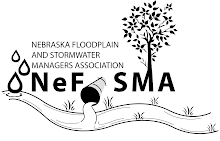Application of HAZUS in Risk Management and Production of Updated Dam Breach Inundation Analyses - Paul Woodward and Carrie Romero, Olsson Associates
The objectives of this presentation are to educate the audience on ways to enhance Hazard Mitigation Plans during their required 5-yr update period. Key subjects presented will include the application of HAZUS in Risk Assessment and the production of updated dam breach inundation analyses.
Because the Papio-Missouri River NRD’s Hazard Mitigation Plan was the first plan adopted inthe State of Nebraska in 2006, it is the first plan to be officially updated before the mandatory 5-year deadline. However, as this presentation will emphasize, the 5-year update really isn’t a requirement, it is an opportunity to expand the possibilities of what can be achieved through hazard mitigation on multiple levels. First, FEMA and the Nebraska Emergency Management Agency are striving to get more entities involved, including schools and non-profits. Second, the range of hazards and the variety of potential actions is growing to meet the demands of thesenew agencies and to better accommodate beneficial projects.
The focus of our presentation will be to highlight the differences between the 2006 and the 2011P-MRNRD Hazard Mitigation Plan. One major difference between the two plans is the methodology used for overall risk assessment. While the original plan presented extensive historic evidence for potential hazards, the new plan utilizes FEMA’s Multi-Hazard Loss Estimation Software, HAZUS-MH. Using CENSUS and enhanced data available from local GIS sources, HAZUS-MH was able to provide damage estimates for earthquakes, floods, dam and levee failures.
One example of improved data was new analysis or redelineation for over 20 high hazard dams in the P-MRNRD. Where LiDAR and property parcel data was available, dam breach inundation maps were updated to accurately show the limits of impact and to produce a database of affected property owners should they need to be contacted during an emergency. In fact, these updated maps are not only used in the Hazard Mitigation Plan, but have been updated in Local Emergency Operations Plans for each dam and have been put to use in some local desktop exercises.
The last key difference between the original plan and the updated plan is the mitigation goals and the opportunities for using better risk assessment data to support a wide range of mitigation projects. Example mitigation actions, programs or projects include storm shelters, flood and tornado warning systems, drainage and channel improvements, property buyouts, revised flood hazard maps, backup generators, burying power lines, encourage proper tree maintenance, stormwater management, and many others.
About Our Association

- Nebraska Floodplain and Stormwater Managers Association
- The Nebraska Floodplain and Stormwater Managers Association (NeFSMA) is an active organization of over 100 members representing over 50 organizations. NeFSMA pursues multiple purposes including: 1.)promote public awareness of floodplain and stormwater management; 2.) promote the professional status of floodplain and stormwater management and secure all benefits resulting there from; 3.) promote cooperation and information exchange between individuals and entities concerned with floodplain and stormwater management; 4.) keep individuals concerned with floodplain and stormwater management well informed through educational and professional seminars and to provide a method for dissemination of information, both general and technical; 5.) inform and educate concerned individuals of pending floodplain or stormwater legislation, funding and other related management matters. Please browse our website to learn more about NeFSMA at www.nefsma.net. If you are interested in joining, either contact one of the board members or complete the membership form.
Monday, June 6, 2011
2011 NeFSMA Conference - HAZUS Dam Breach Inundation Analyses
Labels:
Conferences,
dam,
HAZUS,
levee
Subscribe to:
Post Comments (Atom)

No comments:
Post a Comment